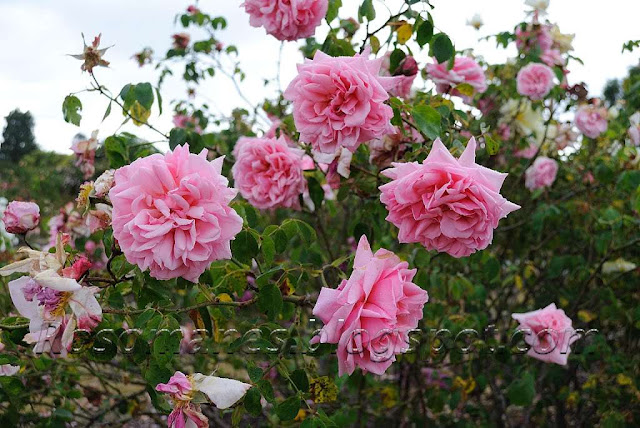...And true it is that ... in all perfect shapes
a blemish bringeth rather a liking every way to the eyes than a loathing any way to the mind. " John Lyly, Euphues: The Anatomy of Wit.
And so with hands bleeding after hours of pruning, I will still write about the beauty of a rose. But not today. The beauty will not awaken until spring, but the blemishes stand out in all their viciousness. And while I can see them so clearly I thought I would go through the best and the worst in my garden.
For the bloodthirstiest, nastiest prickles I turn to my rugosas.
This is Purple Pavement, the epitome of aggression, with thin needle-like prickles sticking straight out looking to make deep piercing holes in my flesh. If you want to deter wildlife, wayward urchins or untoward neighbors, look no further.
And the canes aren't all. This is the underside (petiole) of an old leaf. Still those long sharp
epee-like prickles.

Can it get worse? Yes! This is Basye's Purple Rose, with the same prickles facing straight out, except bigger and more. I remember reading once (but can't find the source anymore) that Dr. Basye discarded this rose because it came too far from his original goal of hybridizing thornless roses....
My personal award for the gentlest and smoothest caned rose goes to Crepuscule, a Tea-Noisette and one of my favorite roses.
Not a prickle anywhere on my two plants, canes or leaves.
I should have more of them...
Second place goes to 'Sophie's Perpetual', a found rose, maybe Bourbon, maybe China.
Not a prickle on mine.
Zephirine Drouhin, a beautiful bourbon rose that I grow as a climber, deserves honorable mention.
There are thorns on the canes occassionally, and it mildews and rusts a bit, so I can't really say it is my favorite despite gorgeous blooms and an overpowering fragrance.
Speaking about climbers, my thorniest is Joseph's Coat. A beautiful rose...
... with prickles on the old canes...
..and the new...
...on the undersides of leaves (petioles)...
...and on bloom necks. That's a lot of prickles. It has drawn enough blood from me so that I am giving it away this winter. I hope its new owner will enjoy it more carefully and painlessly than I.
One of the reasons I like Teas so much is that there are enough of them with smooth canes that I can enjoy the blooms without my skin being torn to shreds.
This one is a young Amazone (Soncy). Only a few prickles so far.
Souvenir de Victor Hugo. None so far.
Rosette Delizy - a few but widely spaced.
Mme. Berard is a wonderful rose...
... and frequently mentioned as thornless.
It is true that its canes are smooth. But look at this:
While I am writing about my Tea-Noisettes, I have to mention Marechal Niel, not the rose with the most prickles by any means, but the one with the most vicious hooked thorns which grab, sink in and hold.
Finally, an honorable mention: Mme. Caroline Testout, Climbing. I was really taken by those sivery-pink cabbage-like blooms...
I got a few years ago as a harmless 3" long twig and put it by my front door.
What was I thinking? Not only are they huge, but they come in pairs too:
And it grows canes easily 20' long, and lots of them. I am thinking of weaving them into a No soliciting sign.
















